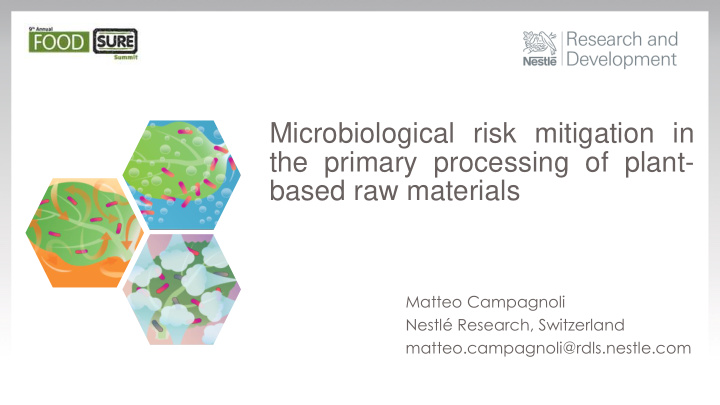



Microbiological risk mitigation in the primary processing of plant- based raw materials Matteo Campagnoli Nestlé Research, Switzerland matteo.campagnoli@rdls.nestle.com
Outline 1 Should we consider the microbiological risk for plant-based raw materials? 2 Supply chain & microbiological risk 3 Mild technologies & scientific challenges Inactivation studies • 4 Washing • Drying • Steaming 5 Guidance booklets overview 6 Creation of shared value 7 Conclusions 2
Why we must consider the microbiological risk for plant-based raw materials 3
Supply chain & microbiological risk GAP GMP 7 Routes of microbial Mild processing contamination • Washing • Growing field and adjacent land • Drying • Animals • Manure-based soil amendments • Steaming • Agricultural water • Hygiene and human health • Worker harvesting practices • Equipment, premises and transportation 4
Supply chain & microbiological risk Mild Nestlé Growing Harvesting Consumer processing NO control Candying / NO control Washing Control measure drying measure (RTE) measure, e.g. e.g. GAP pasteurization 5
Upstream supply chain & microbiological risk management Supplier Nestlé • GFSI approved certification • Nestlé technical audits Development of improve internal technical expertise guidance booklets and auditing tools on mild • Supplier continous improvement processing voluntary training 6
Translation of science into application Scientific studies External experts Guidance booklets & auditing tools Internal experts 7
Mild technologies: scientific challenges • Technologies with limited heat load (no official guidelines available) • Product changes in moisture throughout processing • Dynamic microbial behaviour towards heat resistance • Impossibility to run prediction models • Understand microbial inactivation at lab and pilot plant scale • Identify suitable surrogate microorganisms 8
Raw materials selection Selection criteria: • Vegetables Volumes Fruits • Processing at supplier • Risk assessment for Nestlé finished products Herbs & spices Onion (air-drying) Basil (air-drying) Blueberry (candying) Raisin (air-pasteurization) Freeze-dried basil (steaming) Black pepper (steaming) 9
Inactivation studies: washing • Collaboration with Ghent University • Literature review on processing and inactivation • Expert opinion on safe processing for 4 chemicals • Delivery of one fact sheet for each chemical 10
Washing booklet: content 11
Inactivation studies: drying aw 0.99 aw 0.95 • Definition of process conditions delivering 4 log 10 reduction • Identification of surrogate for process validations 12
Microorganisms PATHOGENS SURROGATES • Enterococcus Sourced from national culture Salmonella spp faecium ATCC collections 8459 • Linked to previous outbreaks • Linked to the specific raw material Escherichia coli P1 STEC • Known for high heat resistance ATCC BAA 1427 Listeria Listeria innocua monocytogenes Hepatitis A Virus Murine Norovirus (HAV) (MNV) 13
Drying booklet: content 14
Drying booklet: content 15
Drying booklet: content 16
Inactivation studies: steaming Inoculation 1% w/w + holding at 22°C / 4 days PATHOGENS SURROGATES Enterococcus Salmonella spp faecium ATCC 8459 Escherichia coli STEC P1 ATCC BAA 1427 Listeria monocytogenes Listeria innocua 17
Steaming booklet: content 18
Steaming booklet: content 19
Auditing tools • 1 checklist for each technology • Presence of scoring system • Used as pre-audit assessment tool • Can be used for continous improvement at supplier level • Booklets to support checklists • Used for training of auditors and suppliers 20
Communication Internal External Corporate Quality Product Associations Supplier Quality Assurance Health Authorities Network Procurement Private companies Corporate website: https://www.nestle.com/aboutus/suppliers 21
Shared value creation 22
Conclusions In the supply chain of mildly processed raw materials, it is key to minimize microbiological contamination and maximize inactivation. The R&D work done provides clear guidance on the microbial surrogates to use on each technology for process validations and the key process parameters to control for maximizing microbiological inactivation. Mild technologies (e.g. air-drying) tipically applied for quality objectives and not food safety, could also be considered control points for microbiological hazards. In the abscence of globally recognized guidelines, mild process conditions need a validation study to prove safety. 23
Acknowledgments Nestlé Research: Sophie Zuber Françoise Julien-Javaux Matteo Campagnoli Frederique Cantergiani Laurence Blayo Thierry Putallaz Sophie Butot University of Gent, Belgium : Lise Michot Prof. Mieke Uyettendaele Xi Bai Prof. Frank Devlieghere Yingyi Zhang Prof. Imca Sampers Adrianne Klijn Zijin (Cece) Zhou Mireille Moser Bühler: Nicolas Meneses 24
Questions… 25
Recommend
More recommend